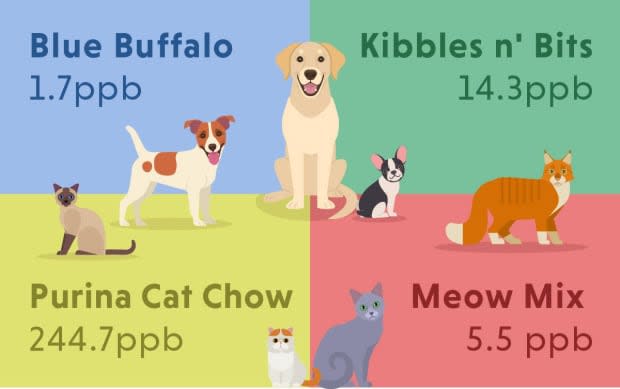New Study Shows Dangerous 'Forever Chemicals' in Popular Pet Food Packaging
You'll want to take a look if your pet's food is on the list.
Pet owners waste no time jumping into action when it comes to food recalls (and rightfully so), but we never would have guessed that the packaging pet food comes in can hide something dangerous.
New data from The Environmental Working Group, or EWG, suggests that pet food bags are yet another way that people and animals are being exposed to a group of 'forever chemicals' called PFAS. These toxic substances can already be found in a surprisingly large number of everyday items, including kitchen items and personal care products, but the levels in some brands of pet food packaging were significantly higher.

Environmental Working Group
The EWG is a nonprofit that aims to "empower you with breakthrough research to make informed choices," according to its website. The organization commissioned an independent laboratory to conduct studies on 11 different types of pet food from 7 different brands in order to confirm whether PFAS were present.
And they were. To determine this, the independent lab sampled each food packaging for its levels of total fluorine--which is a likely indicator of the presence of PFAS. Every single package that was tested contained a measurable level of fluorine, though only the ones with levels over 100 parts per million were tested for PFAS themselves.
Still, the results are concerning:
- Purina Cat Chow's packaging contained the highest level of Total PFAS, at 244.7 parts per billion (ppb).
- In second place--Kibbles N' Bits contains PFAS in 14.3 ppb.
- In total, 7 different types of dangerous 'forever chemicals' were found in pet food packaging.
To view the entire table of results, take a peek at the EWG's news release following the study. It may seem reassuring, at first, to see PFAS levels as low as 1.7 ppb, but we encourage you not to let your guard down so easily.
"PFAS is so toxic at such low levels that any level really is cause for concern,” EWG's Sydney Evans told WSB-TV. Luckily, the EWG has also stated that there is no evidence of PFAS transferring from the packages to the food. The main concern is the inhalation of the dust--not the consumption of the food itself.
Even so, no pet food manufacturer has addressed or promised the phasing out of these harmful chemicals. For now, it's up to pet parents to stay informed and vigilant--and that's why we're here to help.
Looking for more PetHelpful updates? Follow us on YouTube for more entertaining videos.
Or, share your own adorable pet by submitting a video, and sign up for our newsletter for the latest pet updates and tips.
